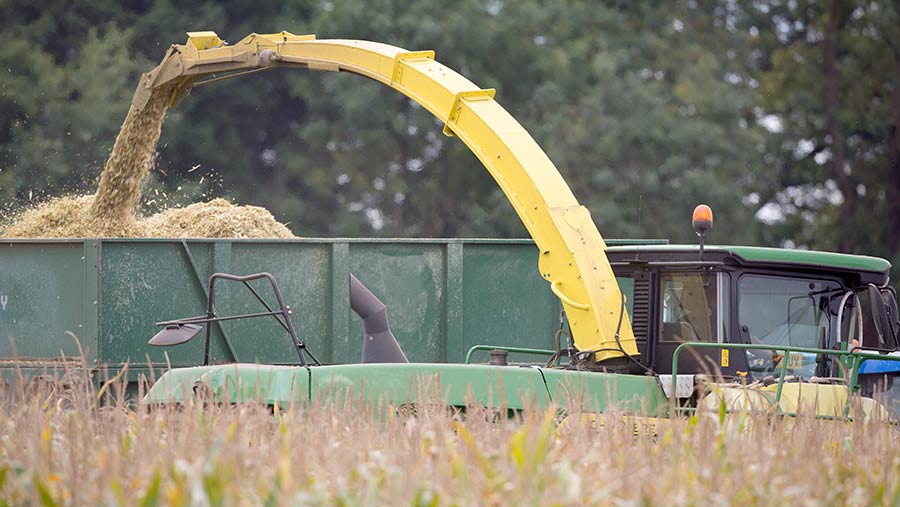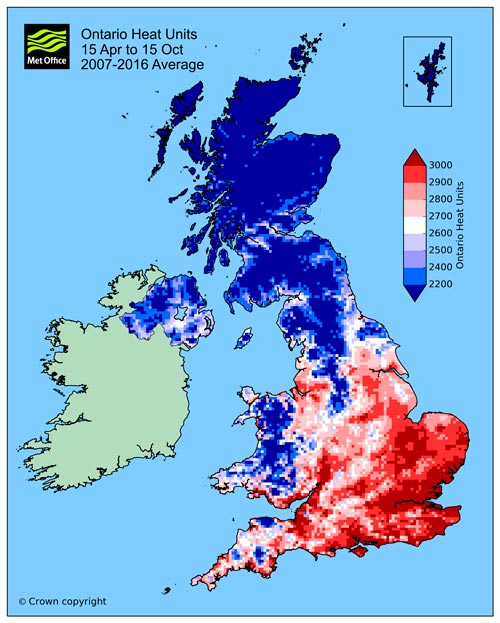How maize Ontario heat units can help variety selection
 © Tim Scrivener
© Tim Scrivener Selecting maize varieties that will mature in time is a key critera when choosing which variety to grow.
There is now an interactive map available to farmers to help them select the right maturing variety for their farm location.
Richard Camplin forage crops technical manager with LG Seeds discusses how it works and how it can help farmers better match maturity class to their location.
See also: Step-by-step guide to planting maize
What are Ontario heat units (OHUs)?
OHUs are the internationally recognised system to show if maize can be grown successfully in a particular location.
How are they calculated?
OHUs are calculated for the maize-growing season from mid-April to mid-October, combining maximum daytime temperatures above 10C and night-time minimum temperatures above 4.4C – the range at which maize actively grows. If there are too few OHUs, crops will struggle to mature which can lead to problems.
What are the problems associated with crops not maturing?
A delayed harvest can potentially lead to harvesting in more difficult conditions, increasing the risk of damage to soil structure.
In addition, it will reduce the opportunity to establish a successor crop, leading to stubbles being overwintered with a greater risk of soil run-off.
From a herd point of view, a delayed harvest will mean maize silage is later going into the diet. In extreme situations, a variety may fail to mature at all.
How do they help farmers select the right maize varieties?
Varieties differ in the number of OHUs required to mature, and this is used to attribute varieties to different maturity classes (see table below).
Knowing how many OHUs a particular variety requires can only be valuable in decision-making if you also know how many OHUs your farm typically receives.
Working with Dan Hollis at the Met Office, LG Seeds has developed an interactive map which shows the 10-year average OHU data across the country broken down into 5km blocks.
This tool allows an enhanced level of accuracy, helping ensure varieties are selected that are suited to the farm.
The map will give an indication of average OHU accumulation, but there can be significant swings around the average which need to be borne in mind.
|
Variety class |
FAO and maturity class |
OHU required |
|
Very early |
FAO 140-180 MC12-9 |
2,500-2,750 |
|
Early |
FAO 180-200 MC 9-7 |
2,750-2,900 |
|
Later |
FAO 200-230 MC 7-4 |
More than 2,900 |
How does the map work and what information does it tell you?
The map (below) shows the national average picture.
- The red areas are where there are usually sufficient OHUs (2,900+) to consistently grow maize successfully.
- The dark blue areas are those unsuitable for growing maize with less than 2,400 OHUs, while the marginal areas are shown in the bordering lighter colours.
The map only records heat units, but what other factors need to be considered when choosing varieties?
Other factors will have a bearing on how successfully plants mature including soil type, altitude and topography, which all impact on the actual OHUs accumulated.

By increasing the degree of precision with which varieties can be selected, this new information will improve the prospects of high-quality feed from a variety suited to the farm and location while helping meet increased environmental concerns.
If success in growing maize is defined as a crop harvested at optimum dry matter and starch contents and in good conditions with minimal risk, then in much of the country the varieties of choice will be earlier maturing.
In really unfavourable blue areas, you could consider growing maize under plastic to accelerate the heat unit accumulation.
However, it may be best to look at other forage strategies as the growing cost and risk associated with maize in these areas may make it uneconomic.
Are there parts of the UK where farmers should not grow maize at all?
Basically anywhere in dark blue on the map.
If growing maize on an intermediate or more marginal site (for example, with OHU below 2,900 units), growers should trade up a whole OHU group, for example moving from early to very early, to reduce risk.
Is there any justification to grow later-maturing varieties in the UK, given the risk to soil health of a late harvest?
Only in areas with very high heat units (for example, dark red) where the risk of failing to mature in a difficult season is minimised. Generally, the trend to earlier varieties is increasing for all the agronomic and risk management advantages
Trial sites

Richard Camplin © Paul Lees
LG Seeds operate trial sites across the UK where more than 100 varieties are compared annually.
One site near Gloucester is in a favourable maize-growing area, while the other two at Bangor-on-Dee in North Wales and St Austell in Cornwall, are in more marginal sites.
Below, Richard Camplin forage crops technical manager with LG Seeds uses data for these sites to demonstrate the differences between years.
Comparing 2016, which was an outstanding maize year with 2012 – which was a very difficult year with low OHU accumulation – illustrates the importance of selecting for the correct maturity class.
The Met Office data analysed by Dan Hollis shows:
- In 2016 the North Wales site accumulated 3,035 OHU compared to just 2,560 OHU in 2012
- This represented a difference of 475 OHU (16%)
- This 475 OHU range covers the full spectrum of varieties available, from 2,500 OHU for very early varieties, through to 3,000+ for later varieties
- In 2012, it accumulated only sufficient OHU to successfully grow the very earliest varieties
- The Gloucester site saw a slightly smaller 433 OHU difference between the two years; 3,177 OHU in 2016 and 2,744 OHU in 2012, but crucially at sufficiently higher levels meaning a wider choice of varieties could be grown safely
Below are some key stats from comparing these different growing years and what the differences mean in practice:
What does this data show?
While later-maturing varieties may yield more, the risk is that they will not mature and with 60% of the country being marginal for maize farmers have to question if the potential risk outweighs a potential yield advantage?
We would recommend selecting varieties which can be grown comfortably within the average OHU.
It is better to err on the side of caution than to stretch the point, because we know there will be extreme years.
If the average OHU postcode score is close to 2,750, it may be better to select a variety with a lower score which will mature earlier, rather than a higher-scoring variety that is slightly later maturing.
